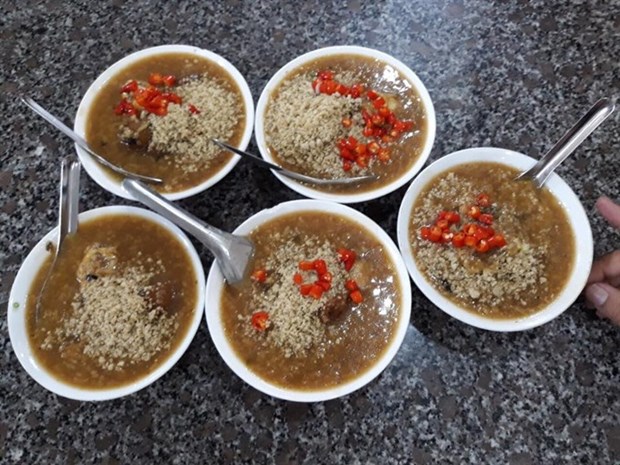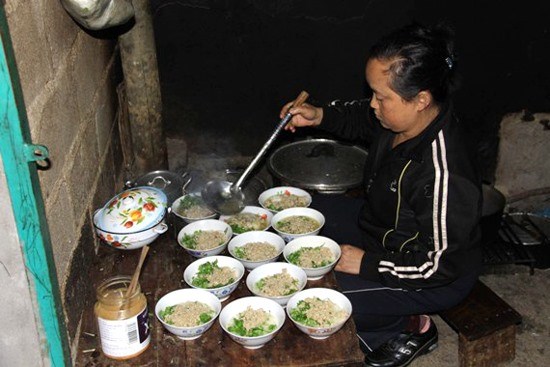The Northern most province in the country is no longer a “remote area” in the tourism sense of the word.

Toxic, medicinal: Ấu tẩu, scientifically known as Aconitum, is a root found in high mountainous areas. Residents of Ha Giang province use it ấu tẩu root and soak it in local wine. The mixture is used for massage or curing minor pain. It is also used to make a rice porridge unique to the province. – Photos hagiangonline.com
Hà
Giang is now known all over the world for its spectacular landscapes including
golden terraced rice fields, limestone peaks and outcrops, valleys of flowers
and the cultural diversity of its ethnic minority communities, who comprise
almost 90 per cent of its population.
With
such a multi-cultural makeup, it is not surprising that Hà Giang’s cuisine
reflects the diversity and many of the dishes found here are unique, and some
of the have become well known, like thắng
cố (simmered horse meat and offal), thắng
dền (boiled glutinous rice dumplings stuffed with mung beans) and grilled
algae.
But
there is one dish which is very popular among locals and easy to find, but
visitors, especially those making their debut in the province, find it
intimidating because it is called “poisonous porridge.”
One
of its main ingredients gives the dish a bitter taste, and people warn you that
it can cause harm if not made well, but its popularity and ubiquitous presence
in the city shows it is worth checking out.
The
cháo ấu tẩu, is a rice porridge with
pork leg, stir-friend minced pork, and the ấu
tẩu root.
Locals
in Hà Giang are experts in using expert ấu
tẩu, they know how to eliminate the poison in the root and combine it with
rice, making it a dish that is actually healthy, helping ease joint pain and
aiding sleep.
Though
I’d been to Ha Giang before, I had stayed mostly in the remote districts like Đồng
Văn, the karst plateau park and Hoàng Su Phì, the land of terraced rice fields.
It was only in latest trip last week that I had the chance to visit Ha Giang
City and have ấu tẩu porridge for the
first time.
“A
trip to Ha Giangy is not complete without having a bowl of ấu tẩu porridge,” my local friend Lê Văn Ước.

Uniquely Ha Giang: Apart from dishes like thắng cố (simmered horse meat and offal), thắng dền (boiled glutinous rice dumplings), grilled algae, no visit to Ha Giang Province can be complete without trying a bowl of cháo ấu tẩu.
Strolling
along the city’s streets in misty, cold weather, I realised how different it
was from what I had expected. The street was quite busy at night, offering a
broad range of street food, with ấu tẩu
porridge stalls the most populous.
Trần
Hưng Đạo Street has the highest number of ấu
tẩu porridge eateries, and “among them, Hương’s is the best,” my friend
said.
Nguyễn
Thị Hương, a Hà Giang native, has been selling ấu tẩu porridge for years. She said the ấu tẩu tree grows mostly in the 2427m high Tây Côn Lĩnh, the
highest peak in the province.
“The
Mông and Dao people go to the peak to get the ấu tẩu root and soak it in wine. The mixture is used as a massage
lotion or balm for curing minor pains,” she said.
To
use ấu tẩu as food, we have to be
careful in processing it. Otherwise, it can poison diners,” Hương said,
confirming what I’d heard earlier.
Ấu tẩu, which has the scientific name of
Aconitum grows typically in high mountainous areas. Its root is hard as a rock,
and thorny.

Ready to serve: Locals in Hà Giang are experts in using ấu tẩu. They know how to eliminate the poison in the root and combine it with rice, making a porridge that is tasty and healthy.
To
make a big pan of ấu tẩu porridge,
people have to work hard for almost a whole day.
The
most difficult part is making the ấu tẩu
safe.
The
root is first cleaned and soaked in rice water (in which rice had been washed),
for at least four hours or from early morning till noon. It is then taken out,
cleaned again, and simmered in boiling hot water for another four hours. At
this point, the root is safe and edible, and locals grind it for adding to the
porridge, which itself is simmered with pork leg.
To
make good porridge, locals use rice grown in hills. This rise is soaked in
water from previous night till early morning so that the dish is soft and
creamy.
Stir
fried minced pork, pepper, scallion, perilla and chilli are added to the ấu tẩu porridge.
While
the ấu tẩu gives the porridge a
bitter taste that might put off the first time diner, the creaminess of rice
and the sweetness of pork bones reduce the bitterness and create a unique
taste.
“Ấu tẩu porridge is served only in the
evening because it is said to be good for sleeping,” Ước said.
“In
the cold climate of a high mountainous area like Hà Giang, nothing can soothe
you better than bowl of hot ấu tẩu
porridge,” he added.
By VNS